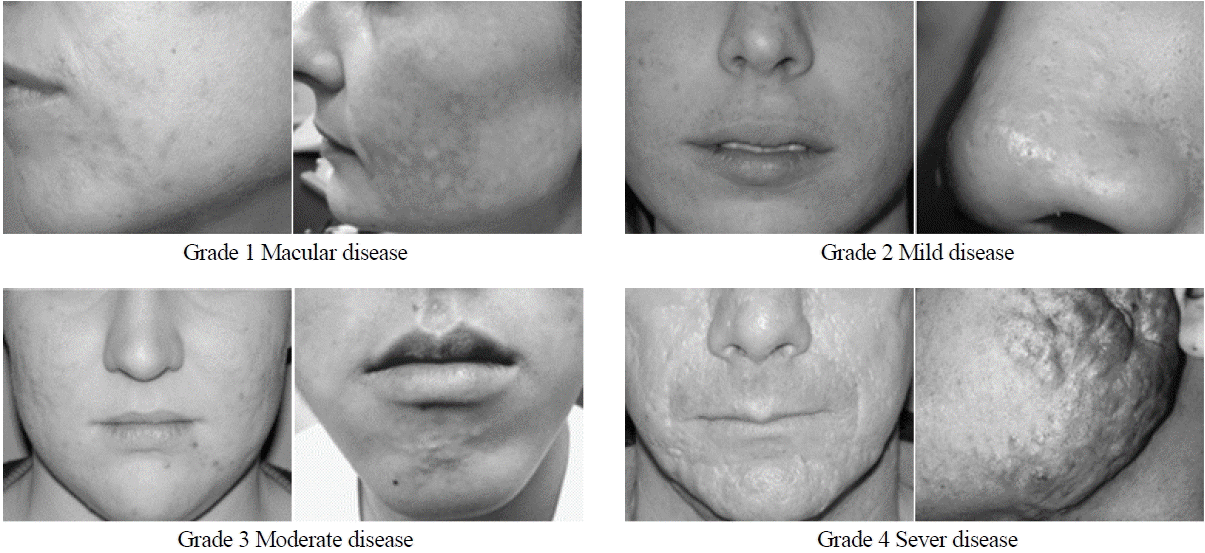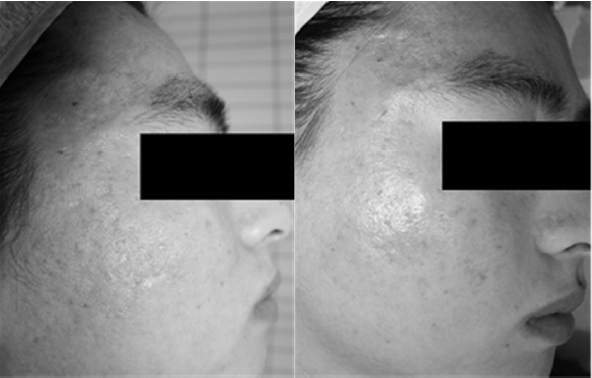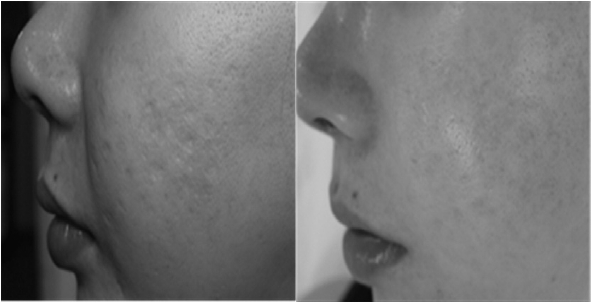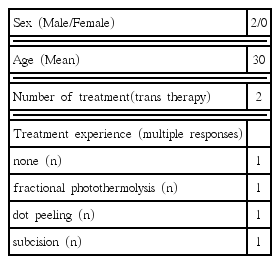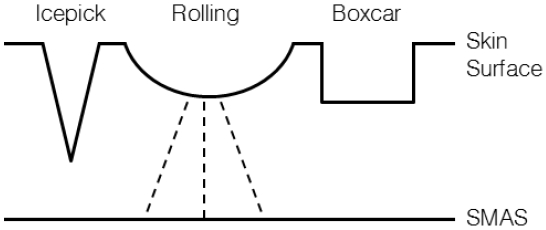Transtherapy for moderate to severe acne scar: a study of 2 cases
Article information
Abstract
Objectives
The purpose of this study is to present effect of transtherapy which is treatment of Korean Medicine to acne scar patients.
Methods
We used transtherapy to moderate and severe acne scar patients and evaluated by a Photo evaluation with 10-point score and Qualitative Global Acne Scarring Grading System.
Results
After transtherapy treatment, mean of Qualitative Global Acne Scarring Grading System of patients changed from 3.5±0.71 to 1.5±0.71. Acne scar showed an improvement at least 8 up to 9 and mean of their acne scar improvement scores was 8.33±0.52 on photo evaluation with 10-point score.
Conclusions
This paper shows that transtherapy in the treatment of moderate to severe acne scars is beneficial for promoting skin regeneration.
Introduction
Acne is a disorder that appears in various forms, such as comedones, papules, pustules, nodules, and clot, mostly occurs in adolescence1–2). About 80–90% of adults in Korea are known to be experienced or currently suffering from acne3). The pathogenesis of acne is still remain unknown, but 4 factors are expected to play an important role: (1) trichilemmal keratinization, (2) increased sebum secretion, (2) bacterial growth, (3) inflammation4).
Acne scars can be divided into two major types: (1) pigmentation of the skin, red marks of the skin (2) defects of the skin caused by necrosis of skin tissue. Symptoms like pigmentation or red marks may disappear over time, but defect type scars that caused by severe inflammation and defect to the underlying tissue or dermis remain intact over time5).
In the treatment of acne scars, laser resurfacing or chemical peels, invasive methods (punch elevation, subcision), and injection of tissue expanders (hyaluronic acid, collagen, fat, etc.) in depressed scar points shown to good effect, but moderate to severe scars of tissue defect types have shown the limits6–9).
Recently, in complementary medicine, treatments such as herbal medicine10), topical herbal compress11), and micro-acupuncture12–14) has been reported that represents a good effect in the treatment of acne itself. Still, treatment for acne scars and study about that is insufficient. In this study, we performed acupuncture treatment which is an application of Korean Medicine to patients with acne scars and report several case with good effects.
Methods
1. Patients
We presented our experience with 2 patients who met following three conditions between November, 2014 and October, 2015 in the Empress Oriental Medical Clinic.
(1) Patients with acne scars (2) moderate to severe acne scar (grade 3 or 4 of qualitative global acne scarring grading system) (3) no other underlying facial diseases. During treatment for this study, other drugs or therapies that may affect the acne scars were not permitted.
2. Treatment process
Before treatment, we wipe off the ointment of the treatment area with gauze, and then sterilize with povidone-iodine (Gumi povidone iodine soln, Gumi Pharm), cover the face with surgical drape with small hole and expose the treatment area. Then we performed transtherapy with 26G precision needle on the acne scars that are deep or wide. After transtherapy, we sterilize with povidone-iodine again, and press treatment area using 4×4 gauze for complete hemostasis, and wipe blood marks out with 4×4 gauze soaked in saline.
3. Acupuncture: Transtherapy
Acupuncture treatment used in this study named “transtherapy”. This therapy combines perspective of Korean Medicine theory and the conventional invasive methods that make wounds below the scar and induce regeneration. With inflow of healthy skin tissue from around scar tissue to scar site, this therapy stimulates the circulation of Qi and blood, helps ensure easier regeneration. Transtherapy was performed a total of two times at intervals of 1–3 months according to the patient’s condition. The patients received the secondary treatment after his primary care to reduce swelling on face and skin redness.
Transtherapy was performed with a precision needle of 26G 1/2inch. (Disposable needle, BD) First, for incision between the epidermis and upper dermis of bottom of the scar, needle is shallowly inserted from 1–2mm side of the scar. Next, we extended the incision 1mm around the scar for micro-transplantation of the surrounding normal skin tissue.
Skin wrinkles can occur during insertion procedures. So in order to perform the treatment with correct depth, we have to hold the skin right next to the needle-inserted skin surface by assisting hand. The skin is to be maintained flat. When the needle passes tissues under the scar and reach the other normal skin tissue of the scar, the skin must be kept flat. In this process, the needle is put through the epidermis and dermis, that is, stratum basale or upper dermis. At the time of procedure, needle is passed through 0.1–0.2mm under the skin, enough to show through the skin. It should be a constant depth of needle procedures both the unit and the peripheral scar tissue. This procedure is to be 2–5 times per scars, so become a fan-shape. Scars are flat and filled with bright red rash immediately after treatment.
4. Assessment
1) Photo evaluation with 10-point score
Before transtherapy, over 10 facial photographs per patients were taken, to reveal acne scars well. 3–6 months after the procedure, photographs taken in the same condition were used to evaluate the final changes of patients. To assess the improvement of acne scar, three clinicians evaluate photos to 10-point scale (0-no change, 10-no scar) independently, and we used median value of three evaluations for final change score.
2) Qualitative Global Acne Scarring Grading System
We classified the severity of symptoms of acne in patients based on the Global Acne Scarring Grading System in order to obtain objective assessments of acne severity before and after treatment (Fig. 1) (Table 1)15).
Case Report
〈case 1〉
A 28-year-old male patient with no relevant treatment experience. Acne occurs in high school age. Transtherapy was performed a total of two times at intervals of 1 month. Final evaluation was performed at 2.5 month after the last transtherapy. Before the treatment, bumps and dents appears prominently across the forehead and cheeks widely. After the treatment, most dents became flat, the status of remaining of some bumps and pigmentations was observed (Fig. 2).
〈case 2〉
A 32-year-old male patient who has experience fractional photothermolysis, subcision, and dot peeling in dermatology clinic. Acne occurs in middle-high school age. Transtherapy was performed a total of two times at intervals of 1 month. Final evaluation was performed at 3 month after the last transtherapy. a number of boxcar type acne scars seen around the cheeks was lost after the treatment. According to the qualitative global acne scarring grading system, grade 3(moderate) scars became grade 1(macular), erythematous, hyper-pigmented flat marks (Fig. 3).
Results
2 patients were male and their average age were thirty years old. According to their medical history, 1 patient has never had acne treatment and another patient had fractional photohtermolysis, subcision, and dot peeling (Table 2).
In clinical evaluation before and after treatment by three clinicians, Qualitative Global Acne Scarring Grading System of patients changed from 3.5±0.71 to 1.5±0.71. Scores of acne scar improved at least 8 up to 9 scores on photo evaluation with 10-point score and average of their acne scar improvement scores was 8.33±0.52 on photo evaluation (Table 3).
Discussion
Acne is a relatively common skin disorder. 4 factors - (1) abnormal trichilemmal keratinization (2) increased sebum secretion (3) bacterial growth such as propionibacterium acnes (4) inflammation - are expected to play an important role to cause acne. Some of patients with severe inflammatory responses and tissue damage and defect may have permanent scarring, and are often stressful in social life5).
Scars of tissue defect type that appear depressed shape on the surface of the skin are classified according to the appearance of scars: rolling type, boxcar type, icepick type. These scars are known to be difficult to recover compared to the pigmentation type scars16).
The way to treat scars like this defect type is dermabrasion to cut out around the scar tissue or surgical methods such as punch graft, punch elevation, and punch excision. The most frequently used method recently is to scratch the bottom of the scar to occur skin regeneration. There are two ways to scratch the scar: (1) Using sharp metal objects like roller-needle and multiple lancing needle, (2) Using a laser system. (Fraxel laser, ablative fractional CO2 laser) These ways do not need general anesthesia or surgical procedure, procedure is relatively easy and has good effects, so widely used in clinics. This procedure can have good effect if the skin damage is less severe. However, in severe skin damage, less than 20% of normal skin tissue remains below the scar, regeneration is not occur effectively17). In that case, surgical transplant method (punch graft, punch elevation, autologous micro fat graft, and autologous dermal graft) may be used, but there is a risk of side effects compared to treatment effects, so it does not widely used.
Therefore, not only using a method that simply bruised scar to regeneration, micro-transplantation of normal skin tissue of adjacent areas of the scar using needles can increase the effect of therapy. In view of Traditional Korean Medicine, longitudinal flow as well as transversal action (flow of Qi and blood) is also considered important to life support, regeneration and recovery. In this therapy, normal skin cells may move from not the bottom wall (longitudinal direction) but the lateral wall (transversal direction) of the scar. Because the cell is moved in transversal direction, so we named this procedure “trans-therapy”. (The meaning of micro-transplantation and movement) “Trans” is meant to be “transcendence, transformation, passing through”, so by passing through skin cells between normal skin tissue and the scar tissue, this therapy helps the movement of the normal skin cells. The process of scratching the bottom of scar is also different from conventional subsicion therapy. Subsicion therapy is aimed at cutting the fibrous bands that connected from lower dermis to SMAS under the scar14). In contrast, transtherapy is not aimed at lower dermis, but aimed at stratum basale and upper dermis that directly affect the regeneration of epidermis. These cells that adjacent to the scar transplanted to under the scar with blood to further probably improve the regeneration effect.
In this study, 2 patients with moderate to severe acne scares received transtherapy twice. Acne scar changing before and after treatment were observed. 2 patients were observed in the change of acne scars before and after treatment photos. Since aimed at improving the depressed scar, in some cases, pigmentations was still remaining.
In clinical evaluation before and after treatment by three clinicians, Qualitative Global Acne Scarring Grading System of patients changed from 3.5±0.71 to 1.5±0.71. Acne scar showed an improvement at least 8 up to 9 scores on photo evaluation with 10-point score. (average 8.33±0.52) Overall, sinking deep scars were getting lost or shallower after treatment, skin regeneration occurred, it seems to be a good therapeutic effect shown.
The advantage of this therapy is less side effects compared to laser therapy and surgical therapy. And this is a general process of skin regeneration rather than an artificial improvement, it can lead to change in a more natural way. More even, relatively deep acne scar treatment is possible, so it can be used widely in clinic. In this study, there were no side effects reported cases, but additional studies are needed for observation of common side effects such as inflammation after therapy. Further studies about adjunctive therapy for enhancing the effect of treatment (including pharmacopuncture) using more cases needed.
Conclusion
In conclusion, transtherapy may be effective in the treatment of moderate to severe acne scars, and could be applied in clinical practice.
Notes
Conflicts of interest
The authors declare that there is no conflict of interest regarding the publication of this paper.
